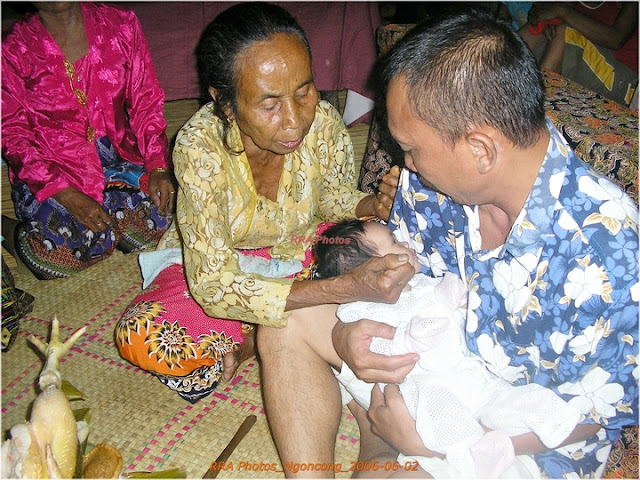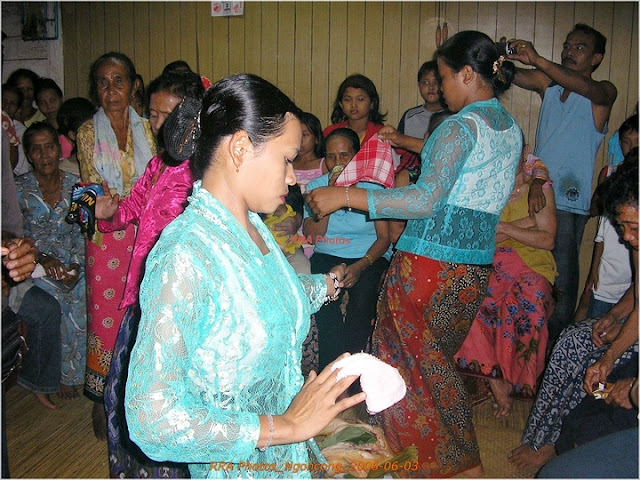Like almost all ethnic cultural traditions, Ngoncong, the cultural heritage of the Salako ethnic community, is fast dying, immersed almost suddenly by the advent of modern forms of entertainment. Back in the 1980's and before, Ngoncong was among the most preferred cultural form of entertainments held during gawe (joyous festivals) of all sorts.
Among those are the Ngarantika, festival marking the start of padi harvesting season; the Ngabayatn, marking the end of padi harvest; the Basunat or male circumcision; the Batenek or the piercing of female ears. The gawe Basunat and Batenek marks the coming of age of Salako boys and girls into "adulthood". Other gawe (joyous festivals) where Ngoncong is considered to be a must is the Nangket or Panganten (marriage), thanksgivings moving in to a new house, or any other merry occasions such as celebrating the plentiful harvest of any other agricultural toils. Others include the Nampukng Tawar (akin to child baptism), Mayar Moot or Mayar Niat such as when a dear family member recovers fully from a serious sickness.
How many nights the Ngoncong is hosted by a family depends on how grand the celebration is, which also reflects on the status of the particular family in the kampokng (village) or area. The most common duration is for a night only but two nights is not uncommon. Three nights is quite rare and seven nights in a row is rarer still but there are stories of such.
The number of dara koncong (female dance performers) varies from one, two, three or seven. This also reflects on how joyous or grand the occasion is supposed to be and this also usually denotes the host's status in the society.
The important actors in a Ngoncong is the panyangahatn who recites the prayer before the do; the panade' (usually senior male) who recites the hymns or mantra during the entire performance; the tuha koncong (lead dancer, usually senior female trainer); the dara koncong (consisting of one, two, three or seven female dancer(s) - usually unmarried in their teens); the pangesek bilola (violin player); the tukang panoko' agukng (the gong player) and the tukang ganakng or panuma' (the person who plays a type of drum or membranophone).
Nyondok is a term used to describe the 'proper' witnessing of a Ngoncong session. These panyondok are seated on stools, chairs or benches usually placed encircling the Ngoncong area. Each session of a Ngoncong usually ends with the batanda' when those panyondok (congregants proper) may dance with the koncongs lasting up to about half an hour or so. Ordinary onlookers who do not nyondok (congregate proper) are not allowed to participate in the batanda'. At the end of the batanda', each panyondok is obliged to contribute a little monetary token as a sign of gratitude and feelings of joy. The session may be repeated till dawn as long as there are "enough" panyondok.
Related article in Salako can be found here.
The kajantera marks the final episode of a Ngoncong. It is also usually the peak where those who do not have the chance to nyondok during the earlier night session(s) would not miss to participate. On most occasions, the kajantera is held on the morning after the gawe has ended.
 A female tukang panyangahatn recites the prayer to the spirits invoking their blessings so that the Ngoncong may be an occasion of joy to both host and guests.
A female tukang panyangahatn recites the prayer to the spirits invoking their blessings so that the Ngoncong may be an occasion of joy to both host and guests. Together with the host (nearest), the koncongs put their hands on the paantaratn which signify their willingness to perform the Ngoncong.
Together with the host (nearest), the koncongs put their hands on the paantaratn which signify their willingness to perform the Ngoncong. The basaru' sumangat when the tukang panyangahatn invokes the good spirits to protect this little child. (This Ngoncong is performed on an occasion of a Nampukng Tawar)
The basaru' sumangat when the tukang panyangahatn invokes the good spirits to protect this little child. (This Ngoncong is performed on an occasion of a Nampukng Tawar) The bakase baangir, (bakase angir) a blessing rituals first begins for the host before on anyone else.
The bakase baangir, (bakase angir) a blessing rituals first begins for the host before on anyone else. The bacaek minyak, or anointing with oil on the forehead is also part of the blessing ritual being performed on the host (the baby). The oil must be from a home brewed coconut oil.
The bacaek minyak, or anointing with oil on the forehead is also part of the blessing ritual being performed on the host (the baby). The oil must be from a home brewed coconut oil. Again the bakase baangir for the panyondoks. This ritual symbolizes the acts of cleansing of hearts and souls upon them.
Again the bakase baangir for the panyondoks. This ritual symbolizes the acts of cleansing of hearts and souls upon them. This act symbolizes the acts of acceptance, willingness and unity between the koncongs and the host.
This act symbolizes the acts of acceptance, willingness and unity between the koncongs and the host. To listen to a Ngoncong audio, please click here.
Acknowledgment:
Thanks to Biado of Nangkat Salako and Kelab Kebudayaan Kpg Serayan, Lundu for the Ngoncong audio.








12 comments:
gambar #9 & #10..
bunga mea kabatne make da'?
artikel yang menarik! syabas n tahniah. selain drpd audio...video ngoncong ngan totongk pun ada mun mauk dikunsi baya-baya. thanks.
www.onesalako.ning.com
Dear Anonymous,
Thank you very much for your offer. Yes, I surely need those materials for my later posts in future.
I will contact you further when the time comes.
Thank you again.
Dear Antogatn_Kayar,
Thank you for your visit and comment.
Bunga an dimake aya daapm gambar koa adalah bunga tamparujatn/parujatn.
Salam dari Biya Kiding.
Melihat kepada gambar paling atas (no. 1) saya dapati ayam itu macam kena 'Squeeze' saja lehernya.
Anyway, thanks for sharing 'adat' bidayuh salako. I am regular reader of your blog.
Very nice and informative article!
Munse dapat adat batenek ngan basunat cara kampunkng agik maruk!
Marek pangatahuant ka adik/anak dirik.
Kaniak dah samuhea moden...
This cultural heritage must be documented before it totally extinct from the Selakau younger generation...
salako bato.... always come out with brilliant ideas.... Ngoncong just part of it. support u always....
This is seriously an interesting and informative post...
I had only seen Ngoncong once and is hoping to see more in the immediate future...
*the pics make me miss home*
Btw, great job! :)
Bato artikel kitak nyian, very informative. Syabas, it won't be dying culture heritage if we the Salakos are taking well care to preserve it.
My statement here might be sensitive to others. Tapi harap dapat menerimanya dengan fikiran yang secara terbuka:
Just hope that ppl can differentiate between adat and agama. Jangan dicampusadukkan, kerana ini akan memusnahkan adat, budaya dan identiti kita sabagai masyarakat Salako.
It is an eye opener to us especially to the younger generation to appreciate more of our Salako Culture.
I am sure you have compile a lot the history of Salakos in your personal collection.
Good job!!!
bato karaja kitak nyian auk.manfaatkan saruruh kaupayaan untuk merealisasikan SALAKO BATO.syabas.
ana ada sabab bah manus an ada damp duniaa ngarasaik d rik a ka he na patut ada
saya budak baru belajar..semoga ada lg artikel ang menambah ilmu pangatahuant aya nian
Post a Comment